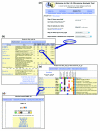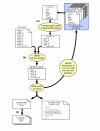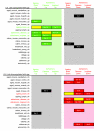L2L: a simple tool for discovering the hidden significance in microarray expression data
- PMID: 16168088
- PMCID: PMC1242216
- DOI: 10.1186/gb-2005-6-9-r81
L2L: a simple tool for discovering the hidden significance in microarray expression data
Abstract
L2L is a database consisting of lists of differentially expressed genes compiled from published mammalian microarray studies, along with an easy-to-use application for mining the database with the user's own microarray data. As illustrated by re-analysis of a recent study of diabetic nephropathy, L2L identifies novel biological patterns in microarray data, providing insights into the underlying nature of biological processes and disease. L2L is available online at the authors' website [http://depts.washington.edu/l2l/].
Figures





Similar articles
-
Gene Aging Nexus: a web database and data mining platform for microarray data on aging.Nucleic Acids Res. 2007 Jan;35(Database issue):D756-9. doi: 10.1093/nar/gkl798. Epub 2006 Nov 7. Nucleic Acids Res. 2007. PMID: 17090592 Free PMC article.
-
MILANO--custom annotation of microarray results using automatic literature searches.BMC Bioinformatics. 2005 Jan 20;6:12. doi: 10.1186/1471-2105-6-12. BMC Bioinformatics. 2005. PMID: 15661078 Free PMC article.
-
Meta-analysis of microarray results: challenges, opportunities, and recommendations for standardization.Gene. 2007 Oct 15;401(1-2):12-8. doi: 10.1016/j.gene.2007.06.016. Epub 2007 Jul 3. Gene. 2007. PMID: 17651921 Free PMC article. Review.
-
GFINDer: Genome Function INtegrated Discoverer through dynamic annotation, statistical analysis, and mining.Nucleic Acids Res. 2004 Jul 1;32(Web Server issue):W293-300. doi: 10.1093/nar/gkh432. Nucleic Acids Res. 2004. PMID: 15215397 Free PMC article.
-
Harnessing the power of gene microarrays for the study of brain aging and Alzheimer's disease: statistical reliability and functional correlation.Ageing Res Rev. 2005 Nov;4(4):481-512. doi: 10.1016/j.arr.2005.06.006. Epub 2005 Oct 27. Ageing Res Rev. 2005. PMID: 16257272 Review.
Cited by
-
Characterization of the early CNS stress biomarkers and profiles associated with neuropsychiatric diseases.Curr Genomics. 2012 Sep;13(6):489-97. doi: 10.2174/138920212802510448. Curr Genomics. 2012. PMID: 23449133 Free PMC article.
-
Selection upon genome architecture: conservation of functional neighborhoods with changing genes.PLoS Comput Biol. 2010 Oct 7;6(10):e1000953. doi: 10.1371/journal.pcbi.1000953. PLoS Comput Biol. 2010. PMID: 20949098 Free PMC article.
-
Transcriptome meta-analysis reveals differences of immune profile between eutopic endometrium from stage I-II and III-IV endometriosis independently of hormonal milieu.Sci Rep. 2020 Jan 15;10(1):313. doi: 10.1038/s41598-019-57207-y. Sci Rep. 2020. PMID: 31941945 Free PMC article.
-
Meta-analysis of muscle transcriptome data using the MADMuscle database reveals biologically relevant gene patterns.BMC Genomics. 2011 Feb 16;12:113. doi: 10.1186/1471-2164-12-113. BMC Genomics. 2011. PMID: 21324190 Free PMC article.
-
An abundant evolutionarily conserved CSB-PiggyBac fusion protein expressed in Cockayne syndrome.PLoS Genet. 2008 Mar 21;4(3):e1000031. doi: 10.1371/journal.pgen.1000031. PLoS Genet. 2008. PMID: 18369450 Free PMC article.
References
-
- Boyle EI, Weng S, Gollub J, Jin H, Botstein D, Cherry JM, Sherlock G. GO::TermFinder - open source software for accessing Gene Ontology information and finding significantly enriched Gene Ontology terms associated with a list of genes. Bioinformatics. 2004;20:3710–3715. doi: 10.1093/bioinformatics/bth123. - DOI - PMC - PubMed
Publication types
MeSH terms
Grants and funding
LinkOut - more resources
Full Text Sources
Other Literature Sources
Molecular Biology Databases
Research Materials

